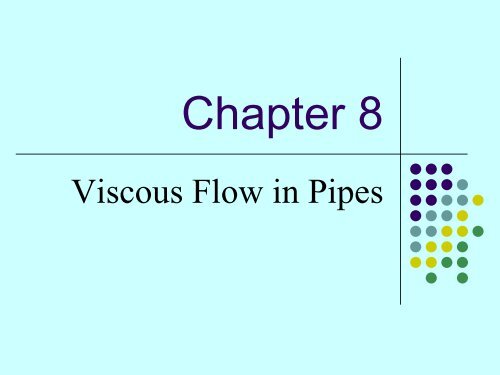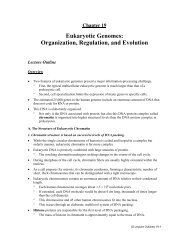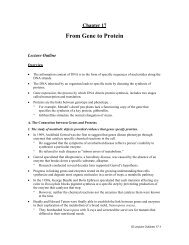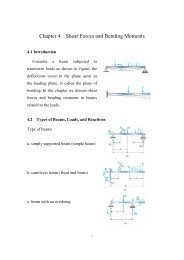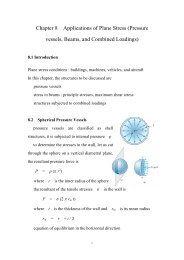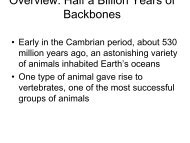Viscous Flow in Pipes.pdf
Viscous Flow in Pipes.pdf
Viscous Flow in Pipes.pdf
Create successful ePaper yourself
Turn your PDF publications into a flip-book with our unique Google optimized e-Paper software.
Chapter 8<strong>Viscous</strong> <strong>Flow</strong> <strong>in</strong> <strong>Pipes</strong>
8.1 General Characteristics ofPipe <strong>Flow</strong>• We will consider round pipe flow, which is completely filledwith the fluid.
8.1.1 Lam<strong>in</strong>ar or Turbulent <strong>Flow</strong>• The flow of a fluid <strong>in</strong> a pipe may be lam<strong>in</strong>ar flow or itmay be turbulent flow.• Osborne Reynolds experiment --typical dye streaksV8.2 Lam<strong>in</strong>ar/turbulent pipe flow
Instantaneous velocity fluctuation• Time dependence of fluid velocity at a po<strong>in</strong>t.V8.3 Intermittent turbulent burst <strong>in</strong> pipe flowTurbulentRe>4000Transitional2100
8.1.2 Entrance Region and FullyDeveloped <strong>Flow</strong>• Consider a pipe flow with uniform <strong>in</strong>let velocityA boundary layer <strong>in</strong> which viscous effect areimportant is produced along the pipe wall such thatthe <strong>in</strong>itial velocity profile changes with distancealong the pipe.
Entrance length• Typical entrance lengths are given byle= 0.06 ReDfor lam<strong>in</strong>ar flowle= 4.4( Re) 16Dfor turbulent flowe.g. Re = 1.0 le= 0.6DRe = 2000 l = 120DFor practical eng<strong>in</strong>eer<strong>in</strong>g problems4 510 < Re < 10 so that 20D< l < 30De• Calculation of the velocity profile and pressure distributionwith<strong>in</strong> the entrance region is quite complex.e
8.1.3 Pressure and Shear Stress• Fully developed steady flow <strong>in</strong> a constant diameter pipemay be driven by gravity and/or pressure force.• For horizontal pipe flow, gravity has no effect except for ahydrostatic pressure variation across the pipe, that isusually negligible.• <strong>Viscous</strong> effects provide the restra<strong>in</strong><strong>in</strong>g force that exactlybalances the pressure force, allow<strong>in</strong>g the fluid to flowthrough the pipe with no acceleration.• In non-fully developed flow, the fluid accelerates ordecelerates as it flows, therefore there is a balancebetween pressure, viscous and <strong>in</strong>ertia (acceleration) flow.
Integral Analysis for Increased Pressure Drop <strong>in</strong> theEntrance Region(From S.R. Turns, Thermal-Fluid Sciences, Cambridge Univ. Press, 2006)The <strong>in</strong>creased pressure drop <strong>in</strong> the entrance region result from tworeasons: 1. flow acceleration, 2. <strong>in</strong>creased wall shear stress.1. <strong>Flow</strong> accelerationIntegral momentum balance for the control volume below leads to4P0A x-sec −P2A x-sec − ∫ τAwdAw = mv &avg−mv&avgw 3Increased momentum flowor flow acceleration
2. Increased Wall Shear Stress:⎡ τ dA ⎤ > ⎡ τ dA⎢∫⎥ ⎢∫⎤⎥⎣ Aw w w ww ⎦develop<strong>in</strong>g⎣ Aw⎦regionfullydevelopedIncreased wall shear stress
Pressure distribution• Pressure distribution drag a horizontal pipe∂p∂xentranceregion∂p> =∂xfully developed regionconstant
Nature of flow• The nature of the pipe flow is strongly dependent onwhether the flow is lam<strong>in</strong>ar or turbulent, which is a directconsequence of the differences <strong>in</strong> the nature of the shearstress.• <strong>Flow</strong> rate as a function of pressure drop <strong>in</strong> a givenhorizontal pipe.VQΔp⋅D=32⋅μ⋅l4π D Δp= −128μlHagen-Poiseuille flowLam<strong>in</strong>ar flow Re
8.2 Fully Developed Lam<strong>in</strong>ar <strong>Flow</strong>• Consider a fully developed flow <strong>in</strong> long straight, constantdiameter sections of a pipe.• There are numerous ways to derive important resultsperta<strong>in</strong><strong>in</strong>g to fully developed lam<strong>in</strong>ar flow.
8.2.1 From F=ma Applied Directly to aFluid Element• Consider a element with<strong>in</strong> a pipe• Free body diagram of a cyl<strong>in</strong>der of fluid• The force balance becomes, (a=0, the fluid is not accelerat<strong>in</strong>g)2 2Δp2τp πr − p −Δp πr − τ 2πrl= 0 → =( ) ( ) ( )1 1lr
• S<strong>in</strong>ce neither Δpnor are functions of the radialcoord<strong>in</strong>ate, r , it follows that 2τr must also be<strong>in</strong>dependent of r .i.e.,τ = Crlwhere C is a constant2τwC = whereτwis the wall shear stressD2τwr→ τ =D• Thus the pressure drop and wall shear stress arerelated by,4 τ wΔ p = l Dl >> 1 D• A small shear stress can produce a large pressuredifference if the pipe is relatively long
• The above analysis is valid for both lam<strong>in</strong>ar andturbulent flow.• To proceed further we must determ<strong>in</strong>e therelationship between shear stress and velocity.• For lam<strong>in</strong>ar Newtonian flow,uτ = μ ∂∂ydudrΔp 2 τ du ⎛ Δp ⎞= , =− ⎜ ⎟rl r dr ⎝2μl⎠Δp∫du=− rdr2μl∫For pipe flow τ = − μ ( τ > 0)Then⎛ Δp⎞⎜ ⎟⎝2μl⎠2u =− r + C1 C1, where is a constant2DΔpDB.C.: u = 0., r = , so that C1=2 16μl
• Hence the velocity profile can be written as,( )u r( )u r22 2⎡ ⎤ ⎡ ⎤ΔpD ⎛2r ⎞ ⎛2r⎞= ⎢1− ⎜ ⎟ ⎥ = Vc⎢1−⎜ ⎟ ⎥16μl⎢⎣ ⎝ D ⎠ ⎥⎦ ⎢⎣ ⎝ D ⎠ ⎥⎦2ΔpDwhere Vc= is the centerl<strong>in</strong>e velocity16μlIn terms of wall shear stress,2τ D ⎡ ⎛1 r ⎞ ⎤= w ⎢ − ⎜ ⎟ ⎥ where R=D is the pipe radius.4μ⎢⎣⎝ R ⎠ ⎥⎦2• Volume flow rate2r=RR⎡⎛ r ⎞ ⎤Q = ∫udA = ∫ u ( r)2πrdr = 2πV 1r 0c ⎢ − ⎥rdr=∫0⎜ ⎟⎢⎣⎝ R ⎠ ⎥⎦π=2RVc2
• Average velocityVQ2 2π RVcVcΔp⋅D= = =22πR2 32⋅μ⋅l4π D Δp= − Hagen-Poiseuille flow128μlLam<strong>in</strong>ar flow Re
• For nonhorizontal pipeThus <strong>in</strong>stead ofΔp−γ ls<strong>in</strong>θ 2τ=l randVΔ p =l2πr( Δ −γls<strong>in</strong>θ) π( Δ −γls<strong>in</strong>θ)p D p D= , Q=32μl128μlIf V = 0, Δ p= γls<strong>in</strong>θ= γΔz2 4
8.2.2 From the Navier-Stokes Equation• Basic equationsur∇⋅ V = 0,ur∂Vur ur ∇pur ur2+ V ⋅∇ V =− + g+ v∇V∂tρ• For steady fully developed flow <strong>in</strong> a pipeur∇⋅ V = 0,r ur2∇ p+ ρgk = μ∇V• In terms of polar coord<strong>in</strong>ate∂p1 ∂ ⎛ ∂u⎞+ ρgs<strong>in</strong>θ = μ ⎜r⎟∂x r ∂r⎝∂r⎠( ) = ( )f x g r= constant,
8.2.3 From Dimensional Analysis• Consider pressure drop <strong>in</strong> the horizontal pipe( , l, , μ )Δ p=F V Dk− r = 5− 3=2D⋅Δp⎛ l ⎞= φ ⎜ ⎟μ ⋅V⎝D⎠dimensionless groups• If we assume that the pressure drop is directly proportionalto the pipe length.2D ⋅Δp ClΔp CμV Δp D= , = ⇒ V =2μ ⋅V D l D l CμorQ( π 4 )4 4C Δp⋅D π D p= AV = =μl⋅Δ128μlThe value of C must be determ<strong>in</strong>ed by theory or experiment.C = 32 for round pipe.
• It is advantageous to describe <strong>in</strong> terms ifdimensionless quantities.32μlVΔ p =2DΔpμlV D μ l ⎛ l ⎞= = = ⎜ ⎟V V VD D ⎝ D⎠232 64641 2 1 22ρ2ρ ρ Re2i.e.,l ρVΔ p= f ⋅ ⋅D 2( ) ( )where f =Δp D l ρV 2 2 friction factor or Darcy friction factorFor lam<strong>in</strong>ar fully developed pipe flow• Alternatively, s<strong>in</strong>cef =64Re4⋅lτwΔ p =DΔp⋅( D l)4⋅lτD 1 8τwf = = =ρV D ρV ρV 2w1 2 1 22l2(8.19)(8.20)
8.2.4 Energy Consideration• Consider the energy equation for <strong>in</strong>compressible, steady flowbetween flow locations.p V p Vγ 2gγ 2g2 21 1 2 2+ α1 + z1 = + α2 + z2 + h2• For fully developed flowα = α , V = V1 2 1 2p1 ⎛ p2⎞+ z1− ⎜ + z2⎟=hLγ ⎝ γ ⎠Δ p 2τ2τl4lτ= ∴whL= , hL=l r γ r γ D(Recall p = p +Δp, z − z =l s<strong>in</strong>θ)1 2 2 1EX. 8.3 Lam<strong>in</strong>ar pipe flow properties⎛Δp−γ l s<strong>in</strong> θ 2τ⎞⎜=l r⎟⎜⎟Δpl s<strong>in</strong> θ 2τ− =⎜ γrγ⎟⎝ l ⎠Which <strong>in</strong>dicates that it is the shear stress at the wall ( which isdirectly related to the viscosity and the shear stress throughoutthe fluid ) that is responsible for the head loss.
8.3 Fully developed turbulent flow• Turbulent pipe flow is actually more likely to occur thanlam<strong>in</strong>ar flow <strong>in</strong> practical situation.• Consider flow <strong>in</strong> a pipe
• Velocity variation at a po<strong>in</strong>t.• Turbulent processes and heat and mass transfer processes areconsiderably enhanced <strong>in</strong> turbulent flow compared to lam<strong>in</strong>arflow.Mix a cup of coffee (turbulent flow)Mix two colors of a viscous pa<strong>in</strong>t (lam<strong>in</strong>ar flow)V8.4 Stirr<strong>in</strong>g color <strong>in</strong>to pa<strong>in</strong>tV8.5 Lam<strong>in</strong>ar and turbulent mix<strong>in</strong>gV8.7 Turbulence <strong>in</strong> a bowl
8.3.2 Turbulent shear stress• Turbulent flow is random and chaotic and can only becharacterized us<strong>in</strong>g stately terms.u = u x, y, zt ,• Mean part( )1=T∫t0+ Ttime average u ( , , , )t0u x y z t dtwhere T is longer than the period of the longestfluctuations, but is shorter than any unstead<strong>in</strong>ess of theaverage velocity.
Turbulence <strong>in</strong>tensity• Fluctuat<strong>in</strong>g partu = u + u′ or u′= u−u1 1′ = ( − ) = ⎡TT ⎣−1= ( Tu − Tu ) = 0T′1 t + T=T∫′ > 0t + T t + T t + T∫ ∫ ∫0 0 0u u u dt udt u dtt0 ⎢ t0 t02 0 2u u dtt0• Turbulence <strong>in</strong>tensity⎤⎥⎦Iu= =u⎡1 t0+ T22u′⎤dt′ ⎢T∫t⎣⎥0⎦u12Well designed w<strong>in</strong>d tunnel: I ≈ 0.01 (may be down to 0.0002)
Time-averaged Navier-Stokes EquationsLet u = u + u′ , υ = υ + υ′ , w= w+w′and then take time average2 2 2⎛∂u ∂u ∂u′ ∂u ∂u′ ∂u ∂u′ ⎞ ∂p ⎛∂ u ∂ u ∂ u ⎞x-dir:ρ⎜ + u + u′ + υ + υ′ + w + w′⎟=− + ρgx+ μ⎜ + +2 2 2 ⎟⎝ ∂t ∂x ∂x ∂y ∂y ∂z ∂z ⎠ ∂x ⎝ ∂x ∂y ∂z⎠2∂u′ ∂u′ ∂u′ ∂u′ ∂u′ υ′ ∂υ′ ∂u′ ∂uw ′ ′ ∂w′But u′ = − u′ ; υ′ = − u′ ; w′ = − u′∂x ∂x ∂x ∂y ∂y ∂y ∂z ∂z ∂z∂u′ ∂υ′ ∂w′and + + = 0 (from cont<strong>in</strong>uity equation)∂x ∂y ∂z⎛2 2 2 2∂u ∂u ∂u′ ∂u ∂u′ υ′ ∂u ∂uw ′ ′ ⎞ ∂p ⎛∂ u ∂ u ∂ u ⎞→ ρ + u + + υ + + w + =− + ρgx+ μ + +⎜2 2 2t x x y y z z ⎟⎜ ⎟⎝∂ ∂ ∂ ∂ ∂ ∂ ∂⎠∂x ⎝ ∂x ∂y ∂z⎠Terms with fluctuations moved and merged to the r.h.s.F<strong>in</strong>ally,⎛∂u ∂u ∂u ∂u ⎞ ∂p ∂ ⎛ ∂u 2 ⎞ ∂ ⎛ ∂u ⎞ ∂ ⎛ ∂u⎞ρ⎜ + u + υ + w ⎟=− + ρgx+ ⎜μ − ρu′ ⎟+ ⎜μ − ρu′ υ′ ⎟+ ⎜μ −ρuw′ ′ ⎟⎝ ∂t ∂x ∂y ∂z ⎠ ∂x ∂x⎝ ∂x ⎠ ∂y⎝ ∂y ⎠ ∂z⎝ ∂z⎠⎛∂υ ∂υ ∂υ ∂υ ⎞ ∂p∂ ⎛ ∂υ ⎞ ∂ ⎛ ∂υ 2 ⎞ ∂ ⎛ ∂υ⎞ρ⎜ + u + υ + w ⎟=− + ρgy+ ⎜μ − ρu′ υ′ ⎟+ ⎜μ − ρυ′ ⎟+ ⎜μ −ρυ′ w′⎟⎝ ∂t ∂x ∂y ∂z ⎠ ∂y ∂x⎝ ∂x ⎠ ∂y⎝ ∂y ⎠ ∂z⎝∂z⎠⎛∂w ∂w ∂w ∂w⎞ ∂p ∂ ⎛ ∂w ⎞ ∂ ⎛ ∂w ⎞ ∂ ⎛ ∂w2 ⎞ρ⎜ + u + υ + w ⎟=− + ρgz+ ⎜μ − ρuw ′ ′ ⎟+ ⎜μ − ρυ′ w′ ⎟+ ⎜μ −ρw′⎟⎝ ∂t ∂x ∂y ∂z ⎠ ∂z ∂x⎝ ∂x ⎠ ∂y⎝ ∂y ⎠ ∂z⎝ ∂z⎠
Orig<strong>in</strong> of shear stress• The shear stress for turbulent flow can not be evaluatedas for lam<strong>in</strong>ar flow, i.e.,τt≠uμ ∂∂y• Lam<strong>in</strong>ar flow : random Turbulent flow: randommotion of molecules. motion of 3D eddies.The eddystructuregreatlyenhancesand promotesmix<strong>in</strong>g with<strong>in</strong>the fluid.
Total stress• Total stressduτ = μ − ρu′ υ′= τlam+ τdyif the flow is lam<strong>in</strong>ar, u′ = υ′ = 0, u′ υ′= 0−ρu′ υ′ ( −ρυ′ w′, K)--Reynolds stresses• Structure of turbulent flow <strong>in</strong> a pipeturb
• Typically the value of τ turb is 100 to 1000 timesgreater than τ lam <strong>in</strong> the outer region, while theconverse is true <strong>in</strong> the <strong>in</strong> the viscous sublayer.• The viscous sublayer is usually a very th<strong>in</strong> layer.(cf. Ex. 8.4)• An alternate way of express<strong>in</strong>g turbulent shear stressτturb• Prandtl mix<strong>in</strong>g length2 duη = ρlmdyτdu= ηdywhere η : eddy viscosity which is a function of both the fluidand flow conditions.22 ⎛du⎞turb= ρlmlm= ?⎜⎝dy⎟⎠
8.3.3 Turbulent Velocity Profile• Typical Structure of the turbulent velocity profile <strong>in</strong> a pipe* law of the walluu *uu *=yu*ν⎛ yu*⎞= 2.5 ln ⎜ ⎟+5.0⎝ ν ⎠where the coefficients aredeterm<strong>in</strong>ed experimentallyviscous sublayer 0 ≤ yu * ν ≤ 5τwu*oru τ=ρfriction velocityV − u ⎛ R ⎞ = ⎜ ⎟u*⎝ y ⎠cIn the central region, 2.5ln is often used
Appendix: Derivation of the law of the wallFor the sublayer, Prandtl suggested <strong>in</strong> 1930 that u be<strong>in</strong>dependent of sublayer thickness, andu = f( μ, τ , ρ, y)wUs<strong>in</strong>g the pi method:a b c1 1Π1= uμτwρ→ a= 0, b=− , c=2 2d e f1 1Π2= yμτwρ→ d =− 1, e= , c=2 2⇒Π = u/ τ / ρ = u/ u*, where τ / ρ ≡u*1ywyu*νΠ2= τw/ ρ =νu ⎛ yu*⎞→ = f ⎜ ⎟u * ⎝ ν ⎠u yu*Experimentally, it is found that = .u * νw
Turbulent Velocity Profile• Empirical power–law velocityuVc⎛= ⎜1−⎝r ⎞⎟R⎠1 nthe value of n is a function of theReynolds number.EX. 8.4 Turbulent pipe flowpropertiesV8.8 Lam<strong>in</strong>ar to turbulent flow from a pipeV8.9 Lam<strong>in</strong>ar/turbulent velocity profiles
8.3.4 Turbulence Model<strong>in</strong>gTime-averag<strong>in</strong>g approach: need to solve the closureproblem for the Reynolds stresses, such as −ρuυ′ ′, etc.Different methods for Reynolds stress closure:• Algebraic (zero-equation) models—by model<strong>in</strong>g the eddyviscosity or mix<strong>in</strong>g length• One-equation models—solve one additional transport equation• Two-equation models—solve two more additional transportequations, such as k-ε model, k-ω model• Reynolds stress transport models—solve the transport equationfor Reynolds stressesLarge eddy simulations (LES)—explicitly solve for thelarge eddies <strong>in</strong> a calculation and implicitly account for the smalleddies by us<strong>in</strong>g a subgrid-scale model (SGS model).Direct numerical simulations (DNS)—directly solve thetransient 3-D Navier-Stokes equations with very f<strong>in</strong>e grids andtime steps
8.3.5 Chaos and TurbulenceChaos theory <strong>in</strong>volves the behavior of nonl<strong>in</strong>eardynamical systems and their response to <strong>in</strong>itial andboundary conditions. The flow of viscous fluid,governed by the complex nonl<strong>in</strong>ear Navier-Stokesequations, is such a system.The chaotic behaviorassociated with thelogistic equation with<strong>in</strong>crease of r:Xnext = rX(1 − X)r=3(from Chaos, by James Gleick)
The Butterfly EffectThe phrase refers to the idea that a butterfly’s w<strong>in</strong>gs mightcreate t<strong>in</strong>y changes <strong>in</strong> the atmosphere that may ultimatelyalter the path of a tornado or delay, accelerate or even preventthe occurrence of a tornado <strong>in</strong> a certa<strong>in</strong> location. The flapp<strong>in</strong>gw<strong>in</strong>g represents a small change <strong>in</strong> the <strong>in</strong>itial condition of thesystem, which causes a cha<strong>in</strong> of events lead<strong>in</strong>g to large-scalealterations of events. Had the butterfly not flapped its w<strong>in</strong>gs,the trajectory of the system might have been vastly different.Of course the butterfly cannot literally cause a tornado. Thek<strong>in</strong>etic energy <strong>in</strong> a tornado is enormously larger than theenergy <strong>in</strong> the turbulence of a butterfly. The k<strong>in</strong>etic energy of atornado is ultimately provided by the sun and the butterfly canonly <strong>in</strong>fluence certa<strong>in</strong> details of weather events <strong>in</strong> a chaoticmanner. (from Wikipedia)
About the difficulty to understand turbulenceOn his death bed, Heisenberg is reported to havesaid, "When I meet God, I am go<strong>in</strong>g to ask him twoquestions: Why relativity? And why turbulence? Ireally believe he will have an answer for the first."A similar witticism has been attributed to Horace Lamb(who had published a noted text book onHydrodynamics)—his choice be<strong>in</strong>g quantum mechanics(<strong>in</strong>stead of relativity) and turbulence. Lamb was quoted assay<strong>in</strong>g <strong>in</strong> a speech to the British Association for theAdvancement of Science <strong>in</strong> 1932, "I am an old man now,and when I die and go to heaven there are two matters onwhich I hope for enlightenment. One is quantumelectrodynamics, and the other is the turbulent motionof fluids. And about the former I am rather optimistic."
8.4 Dimensional Analysis of Pipe<strong>Flow</strong>• Most turbulent pipe flow analyses are based on experimentaldata and semi-empirical formulas.h L =h Lmajor +h Lm<strong>in</strong>or• Major losses : loss associated with the straight portion of thepipe Δ p=F( V, D, l,ε, μ,ρ)• pressure drop and head loss <strong>in</strong> a pipe• For lam<strong>in</strong>ar flow the pressure drop isfound to be <strong>in</strong>dependent of theroughness of the pipe.• For turbulent flow, the pressuredrop is expected to be a functionof the roughness.
Pressure drop• For turbulent flow, the pressure drop is expected to bea function of the roughness.
Pressure drop <strong>in</strong> pipe• We will considerk− r = 7− 3=412Δpρ⎛ ρVDε ⎞= % lφ ⎜ , , ⎟⎝ μ ⎠2V D D0≤ε D ≤ 0.05• Experiments <strong>in</strong>dicate that pressure drop is proportional tothe pipe length.12fΔpl ⎛ ε ⎞= φ ⎜Re , ⎟ρ ⎝ ⎠, Δ p = for2V D D DΔpD⎛ ε ⎞φ Re,= =1 2 ⎜ ⎟2ρVl ⎝ D⎠lρV22- valid for horizontal pipefriction factor
Friction coefficient• For lam<strong>in</strong>ar flowf =64Reε<strong>in</strong>dependent of D• For turbulent flowεf = φ ⎛ Re,⎞⎜ ⎟⎝ D ⎠
Moody chart64f =Re
• Energy Equation2 2p1 V1 p2 V2+ α1 + z1 = + α2 + z2+ hγ 2gγ 2gif D 1= D 2, z z 1=2 (horizontal pipe) with fully developedflow α1 = α2thusl ρVΔ p= p1− p2= γ hL= f D 22l VhL= f D 2 g2L(cf. Eq. 5.89 <strong>in</strong> Section 5.3.4)- Darcy – Weisbach equationvalid for fully developed steady<strong>in</strong>compressible pipe flow horizontal or on a hill.
Determ<strong>in</strong>ation of friction coefficient• In general with• Moody chart1 210% accuracy is best expected• Colebrook formulaV= Vl ρVp1− p2 = γ ( z2 − z1) + γhL= γ ( z2 − z1)+ f D 2Part of the pressure change is due to the elevationchange and part is due to the heat loss associated withfriction effects.1 ⎛εD 2.51=− 2.0 log+f ⎜⎝ 3.7 Re f⎞⎟⎠2
8.4.2 M<strong>in</strong>or Losses• Major losses : loss associated with the straight portion ofthe pipe• M<strong>in</strong>or losses : loss associated with valves, bends,tees,………..M<strong>in</strong>or losses
Loss coefficients for m<strong>in</strong>or loss• The head loss <strong>in</strong>formation for essentially all components isgiven <strong>in</strong> dimensionless form and based on experimentaldata.• loss coefficientKLso thathorLKLh= =L2 12( V 2g)2V= KL⋅2g= φLΔpρV12( geometry,Re)2Δ p = K ⋅ ρV2
Loss coefficients for m<strong>in</strong>or lossFor many practical applications, Re is large, theflow is dom<strong>in</strong>ated by <strong>in</strong>ertia effect.thusΔpKL12= φρV2( geometry)• Equivalent length2 2V leq VhL= KL= f2g D 2gKDLor leq=f• loss coefficientsAn obvious way to reduce loss is to round the entranceregion.
Entrance and Exit <strong>Flow</strong>sFigure 8.22 (p. 438)Entrance flow conditions and losscoefficient (Refs. 28, 29). (a) Reentrant, K L= 0.8, (b) sharp-edged, K L= 0.5, (c) slightlyrounded, K L= 0.2 (see Fig. 8.24), (d) wellrounded,K L= 0.04 (see Fig. 8.24).Figure 8.25 (p. 440)Exit flow conditions and loss coefficient.(a) Reentrant, K L= 1.0, (b) sharp-edged, K L= 1.0, (c) slightly rounded, K L= 1.0, (d)well-rounded, K L= 1.0.V8.10 Entrance/exit flows
Pressure loss• <strong>Flow</strong> patter and pressure distribution for a sharp edgeentrance.The majority of the loss is due to <strong>in</strong>ertia effects that are eventuallydissipated by the shear stresses with<strong>in</strong> the fluid.Only a small portion of the loss is due to the wall shear stresswith<strong>in</strong> the entrance region.
Loss coefficient• Loss coefficients
Loss coefficient• Loss coefficients
Loss coefficient• Loss coefficients
Loss coefficient• Loss coefficients for a sudden expansionp = p = p = pAa b c=A2 31AV1 1 3 3( )1 3 3 3 3 3 3 122p1 V1p3 V3+ = + + hγ 2gγ 2gLAVp A − p A = ρ AV V −VK=h ⎛ A= = 1−V g ⎝ AL12 ⎜122L⎞⎟⎠2V8.11 Separated flow <strong>in</strong> a diffuser
Loss coefficient
Loss coefficient
Loss coefficient
8.4.3 Noncircular Conduits• For noncircular ductfCρVDh= where Reh= , Dh=Reμh4AP2l VεhL= f , relative roughness,D 2 g Dhh
Noncircular Conduits• For noncircular duct• C value2C l Vεf = , hL= f , relative roughness,RehDh 2 g Dh


